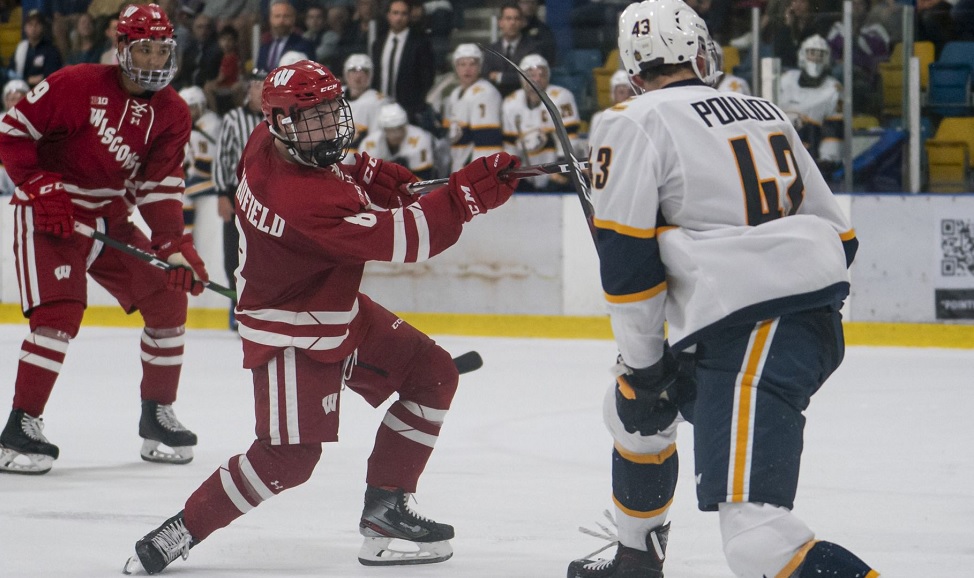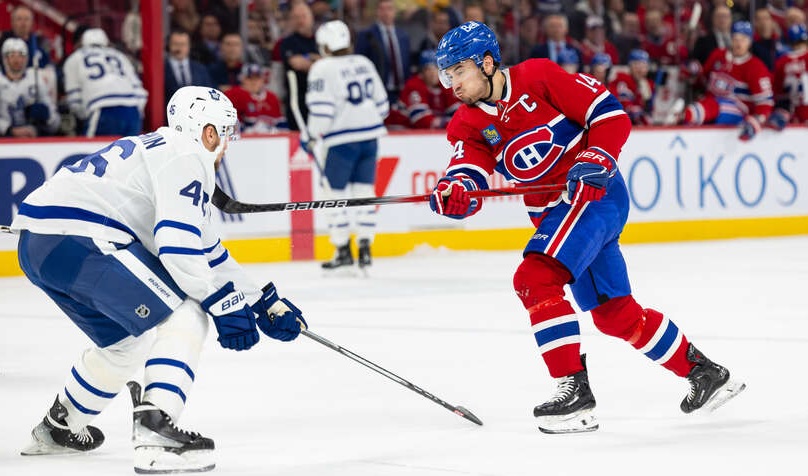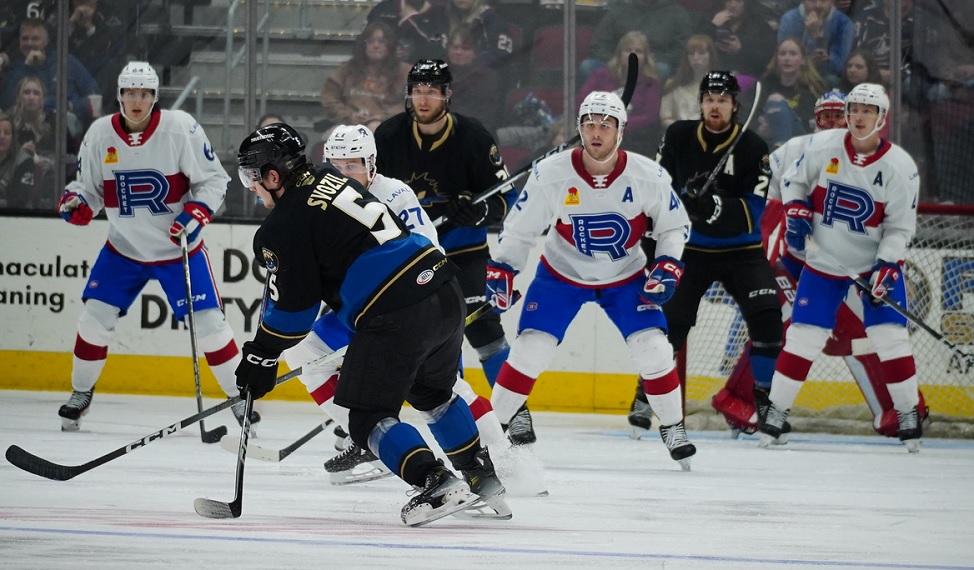HabsWorld.net --
We’ve now reached the top five in our annual prospect rankings series. The battle for the top spot was the closest it has been since we switched to a writer vote – who was selected as Montreal’s top prospect?
Overview
As we’ve done the last few years, the top-10 have been voted on by members of HabsWorld’s writing staff at the beginning of the regular season while I ranked the players from 11 through 38. Here are the criteria that each player had to meet to be eligible to be in these rankings:
1) The player must be 24 years old or younger as of October 1, 2019
2) The player must have no greater than 50 games of NHL experience (including regular season and playoffs)
3) The player cannot be signed to an AHL contract
Here are the departures from last year’s list (previous ranking in parentheses):
Graduated: Jesperi Kotkaniemi (1), Charlie Lindgren (6)
Released: Jarret Tyszka (21), Michal Moravcik (22), Brett Lernout (24), Scott Walford (25), Jeremiah Addison (28), Hunter Shinkaruk (31), Daniel Audette (34), Nikolas Koberstein (37)
Traded: Nikita Scherbak (15 – lost via waivers last season)
Included with each ranking is an estimate of the NHL readiness date for each prospect. For some players, the estimate is a specific season while others whose projected development paths are harder to determine will be in a range.
Rankings
5) Cayden Primeau
Goalie, Northeastern (NCAA)
7th round pick (199th overall) in 2017
Primeau has had quite the ascension in these rankings since debuting at 27 back in the 2017-18 season. He has quickly gone from an intriguing prospect to someone that could plausibly step in and have an impact on the Habs before too long.
After a stellar freshman campaign at Northeastern, Primeau had a strong sophomore year while earning a spot on the USA’s entry into the World Juniors where he wrestled away the number one role. He did well enough that the Habs turned him pro. I want to emphasize that a college goalie (who went straight to college after being drafted) turning pro that quickly is quite rare. It’s a testament to how much he has progressed in a very short period of time.
Having said all of that, there is a reason why most goalies don’t make the jump to the NHL right away. Consistency is usually a concern and there’s adapting to a professional schedule; Primeau doesn’t even have the benefit of playing the more condensed CHL schedule either. While there may be a temptation to have him in the mix to be Carey Price’s backup sooner than later, those are two things that should be enough to hold him back from regular duty for a little while yet. He could very well be the goalie of the future but that future isn’t now.
2018-19 Stats: 36 GP, 25-10-1 record, 2.09 GAA, .933 SV%, 4 SO
Previous HW Ranking: 7th
NHL ETA: 2021-22/2022-23 – If he gets in a full season as Laval’s number one next year and whoever is the backup next season struggles, perhaps they move him up. That said, with Montreal’s goaltending depth, he’s probably not playing 50 AHL games in 2020-21 and the Habs may have to give the new backup goalie a two-year deal this summer thanks to the Seattle expansion. Accordingly, 2022-23 is probably the earliest that he’ll be in the NHL mix.
4) Alexander Romanov
Defenceman, CSKA Moscow (KHL)
2nd round pick (38th overall) in 2018
Heading into 2019-20 (which is when the voting was done), Romanov’s situation was subject to a lot of spin. Yes, he was good enough to play on a top KHL team as a junior-aged player but not a whole lot when you look at his ice time. He was terrific at the World Juniors but a two-week tournament shouldn’t be enough to sway his status as a prospect by any significant margin.
The upside is certainly there when you look at his play against his peers at the World Juniors where he was the tournament’s top blueliner in 2019. While he played a safe style in the KHL, he was much more involved in the play offensively where he showed some upside while providing dependable play in his own end. And then there is the physicality, something he has in spades.
If all goes perfectly, he could be a top pairing player down the road. But with getting limited time in Russia, his development is probably going to be affected by that a little bit. There’s no doubt that he is Montreal’s top defensive prospect but he’s not going to be able to jump in and be an immediate core player with the Habs in 2020-21. Even if he doesn’t quite reach his ceiling, he should be an important part of the future for the Canadiens for years to come.
2018-19 Stats: 43 GP, 1 goal, 3 assists, 4 points, +16 rating, 12 PIMS, 32 shots, 11:23 ATOI
Previous HW Ranking: 8th
NHL ETA: 2020-21/2021-22 – Marc Bergevin has said that he envisions Romanov on Montreal’s roster for 2020-21 but in a limited role. That’s probably Plan A at this point but it’s possible that a larger schedule and a bigger workload relative to his KHL ice time could also wreak some havoc at some point which could delay things slightly. All of this assumes that he signs his entry-level deal, of course, which hasn’t happened just yet but is expected to in the coming weeks.
3) Ryan Poehling
Centre, St. Cloud State (NCAA)
1st round pick (25th overall) in 2017
Poehling showed some flashes that suggest that he’s capable of being an impact offensive player. We saw it at the World Juniors and, of course, his NHL debut against Toronto that saw him score three goals plus the shootout winner. On the other hand, he wasn’t exactly lighting up the NCAA and was more of a complementary player for big chunks of the season.
His two-way game is decent for someone that was deployed primarily as an offensive weapon at the college level and that gives him a high floor in terms of his NHL potential. A centre with some offensive skills, good size, and an improving defensive game is going to get a lot of chances.
The biggest question now surrounding Poehling is his offensive upside. Can he be a consistent threat at that end and not just show it in flashes? That will ultimately determine whether or not he can be a top-six centre for the Habs down the road. There’s little doubt at this point that Poehling will be a regular player for the Habs at some point. But can he be an impact option or will he be more of a depth guy? It’ll take some time to find that out.
2018-19 Stats: 36 GP, 8 goals, 23 assists, 31 points, +12 rating, 32 PIMS, 78 shots, 48.6% faceoffs
Previous HW Ranking: 3rd
NHL ETA: 2020-21/2021-22 – Barring injury, Poehling will certainly see a fair bit of action with the Habs for 2020-21 but with the sudden influx of depth down the middle (that still feels weird to type after what recent years have been like), he shouldn’t be a regular. Montreal’s contract situation in the 2021 offseason will likely facilitate some movement out of their forward group and that should open up a spot for a full-time role for him.
2) Nick Suzuki
Centre, Guelph (OHL)
Acquired in a trade from Vegas in 2018
While Suzuki got a longer look in training camp than he did the year before, he was still sent back to junior last year with a clearly set goal to play with more pace to get him ready to play in the pros. It’s safe to say that he accomplished that as he was once again a top scorer at the junior level and then went on a tear in the postseason where he carried the Storm on his shoulders.
Heading into this season, there were some questions about how his game would adapt to the NHL. While he was a strong junior scorer, he was more of a playmaker than anything else and pass-first players don’t always have immediate success. There were also questions about whether or not he could stay down the middle. I can’t write about his 2019-20 season in this blurb since this was a preseason poll but I think we all know how those questions were answered.
Regardless of Tomas Tatar’s performance with the Habs, getting Suzuki in the Max Pacioretty trade was seen as a nice move for GM Marc Bergevin. His stock was only on the rise heading into this season and let’s face it, it looks pretty good now.
2018-19 Stats: 59 GP, 34 goals, 60 assists, 94 points, +28 rating, 8 PIMS, 277 shots, 54.9% faceoffs
Previous HW Ranking: 2nd
NHL ETA: 2019-20 – If I was writing this in the preseason, I would have hedged a bit and said he’d probably need at least some time in Laval before coming up and establishing himself as a full-time NHL player. He showed that he didn’t really need that after all.
1) Cole Caufield
Right Wing, US NTDP (USHL)
1st round pick (15th overall) in 2019
Caufield earned six out of nine first place votes with Suzuki garnering the other three. However, with Suzuki getting five second place selections and Caufield zero (his other picks were all third place), this wound up being the closest vote yet using our points system (10 points for first, 9 for 2nd, etc).
The enthusiasm is certainly understandable. For years, the Habs have had a major problem with scoring consistently as they lack many true threats. Caufield is one of those top scoring prospects and immediately became one of Montreal’s best scoring weapons the moment he was drafted.
So why did someone that good at scoring goals (72 goals in 64 games last season) drop to the middle of the first round? Simple. He’s really small and is generously listed at 5’7. While small skilled players have a greater chance of succeeding now than they did just a few years ago, there is still a bias against them. The Habs are one of the teams that have shown that they’re not overly concerned with size (or a lack of it) so it’s not surprising that they snatched him up.
While most college prospects are likely to stay for a few years, that isn’t the case with Caufield. While he recently announced he’d be sticking around for his sophomore campaign, it will probably be his last. (And if the COVID-19 pandemic wipes out the ability for the NCAA to have fans in the stands, that could still change.) Once he’s NHL-ready, Caufield will bring a much-needed boost to Montreal’s attack.
2018-19 Stats: 64 GP, 72 goals, 28 assists, 100 points, 39 PIMS
Previous HW Ranking: N/A
NHL ETA: 2021-22 – I could see Caufield needing some acclimation time in the AHL before making the jump on a full-time basis but it shouldn’t be too long before he’s making an impact with the Habs. Suzuki was able to step in and play right away but with Caufield’s size, a slower approach may be more beneficial in the end.


